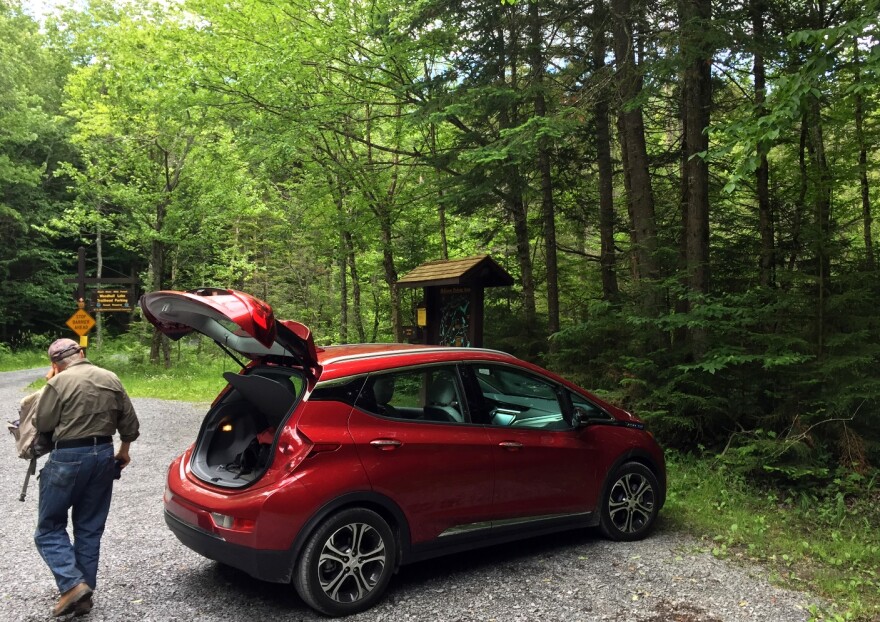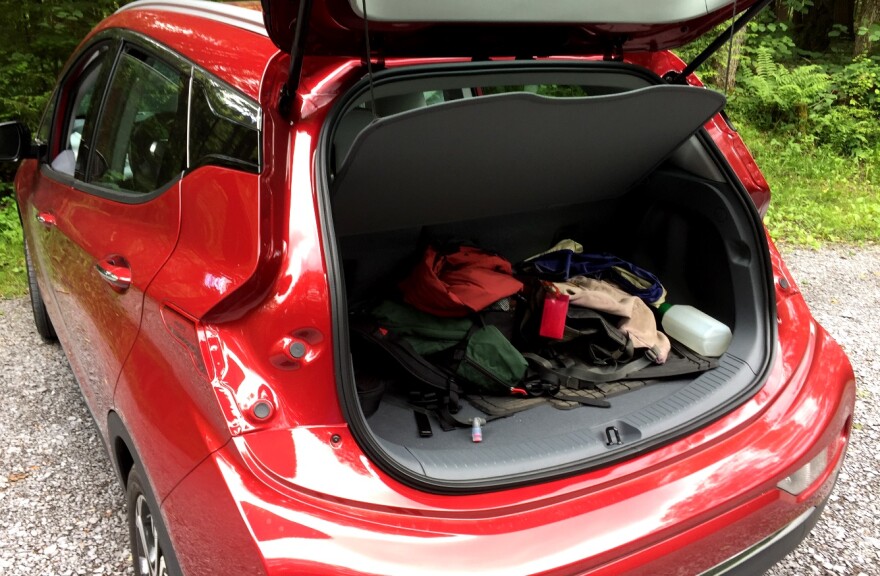What’s it like to drive an all-electric vehicle? What are the impacts – positive and negative – on the environment with such vehicles? How much does it cost…all things considered?
WAER’s Chris Bolt had a chance to answer these questions first-hand during a test drive with a Chevrolet Bolt E-V this week. Chris’s quest was to find out if an all-electric vehicle could be your only car.
Older all-electric vehicles seemed o-k for people with short commutes – a 40- or 50-mile total battery range was fine to get to and from work, maybe a trip to the store. With extended range vehicles, maybe things have advanced to really fit your lifestyle…so it was time to hit the road…
One concern many people have about owning an electrical vehicle is, could it be your main or only vehicle. And we’re going on a road trip to test that out. Obviously the question is a bit different depending on your lifestyle. So we have a trip planned to go to Old Forge, which is 95 miles away, and we’re leaving with an estimated charge of 240 miles on the Chevy Bolt. This is a long-range EV, and we’re going to see just how well the mileage tacks during a trip like this. We might be able to relieve people’s biggest concern about owning an all-electric, which is range anxiety.
The Chevy Bolt E-V I’ve been driving indicates 240 miles on a full charge…you can get a little more by using the regenerative braking, or a little less driving aggressively or uphill. The mileage takes a hit in cold weather and when you use the heater…but there is a system that keeps the battery warm and safe in our cold winters.
So we have arrived at Old Forge and the mileage meter says we have 133 miles of charge left, after traveling the 95 miles from Syracuse. That means we have plenty of power to get back home. It did use up a little more of that estimated mileage than we actually traveled.

For long-distance travel, of course you’d need to charge along the way. During this test drive I was surprised at the time it takes to charge – you get 25 to 30 miles per hour of charging at a commercial level 2 charging station. Level 3 chargers would give you about 160 miles of charge in an hour…but there are only a few out there.
Mobile phone applications to locate charging stations indicated there was a charging station at the Fastrac gas station here in Old Forge. But on arrival we didn’t find any charger. We’re going to check out if there is another place where there’s a charging station in Old Forge.

We didn’t find a charger in Old Forge…which gave us some pause about the accuracy of the apps such as Plugshare, Chargepointor the EV Charging on Google maps or Mapquest. Other E-V drivers and company officials told me they had never before seen a case where phone apps were wrong. So we might have just stumbled on the anomaly. But for our trip…and my lifestyle …it wasn’t a problem this time.
We came up to take a hike in the area and had enough charge to come up to the trail and get home. Here we are at the trailhead and ready to get some exercise.
So hike’s done…and coming out of the environment, we can talk about how environmentally friendly an electric car is.

A Yale study noted that production of the batteries does take additional energy …most of the lithium for the large plate of batteries for electric cars comes from South America or Australia so there’s transportation emissions. Then there’s the question of, how is the electricity to charge your E-V produced…by fossil fuels or renewable means? Other reviews suggest over the life of the car, you’re still producing less than half the emissions.
As we’re on the way home from our road trip, I wanted to answer a cuple more of the questions people posed to me. One was about acceleration. Well, the Chevy Bolt has no problem getting up to Thruway speeds just as quickly as most other vehicles. The all-electric drive train delivers power almost instantaneously, so when you touch the gas you have instant acceleration, so it’s fun to drive and more responsive than many other cars.
Chevrolet boasts the equivalent of 200 horsepower, 0-60 mph in 6.5 seconds.
There is quite a bit of information on the dashboard. Along with the speedometer, there’s the mileage meter that shows you how much charge you have left in the batteries, which even though we had plenty of charge to do the 190+ miles of this trip, I find myself looking at the mileage quite often. There’s also a meter that tells you how much power you’re using or how much you’re charging back into the system through the regenerative braking…and I find myself looking at that gauge often as well. I imagine over time you’d just get used to how those operate and not pay so much attention to them.

People also asked about the overall cost of owning…which Chevy regional Spokesperson Joe Lamiraglia says are lower, never needing an oil change, almost none of the moving parts of a gas engine…and you shouldn’t worry about an expensive battery change.
I think that was one of the things early adopters, the early technology people were wondering about. We’ve engineered the hell out of these batteries, (to last) at least 100-thousand miles. I think the technology is constantly advancing; it’s not a worry anymore. In fact we over-engineered our Volt battery pack and what we learned from that we applied to the Bolt EV and that’s how we got the range. So (battery replacement or failure) is not an issue and is covered under warranty for 100-thousand miles.
Other reviewers have called the Bolt EV a bit of a game changer, a vehicle with a longer battery range – again about 240 miles on a full charge – without the cost of a Tesla or other exotic electric vehicle. The Chevy Bolt ranges in price from about $36,000 to around $43,000. New York State has a $2000 rebate and there’s a $7500 federal tax credit that applies. Add to the peppy driving and longer range, a host of technology – parking cameras back and front, built in wi-fi, your phone apps on the touch screen, lane and crash warnings, -- and I found it an enjoyable and clean alternative.

Long-range travel and charging times have to be managed – a home level-2 charger is pretty much a must (most about $500 - $700 plus installation). So people have another option to reasonably consider as a main car.
In addition the electric vehicle rebate, New York State is subsidizing the installation of 450 additional charging stations to stimulate purchases of E-V’s. It’s part of state efforts to reduce transportation emissions that contribute to climate change.



